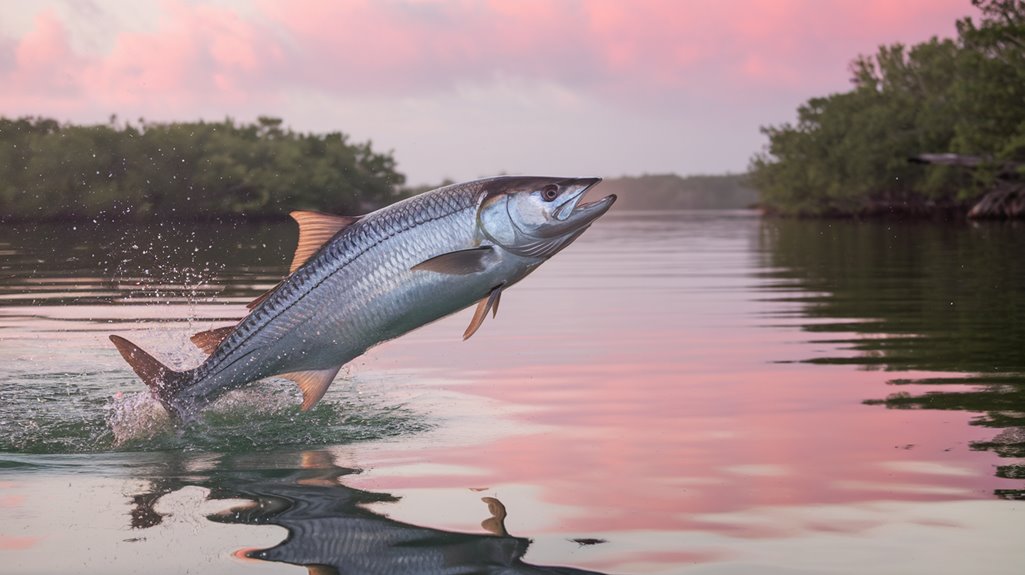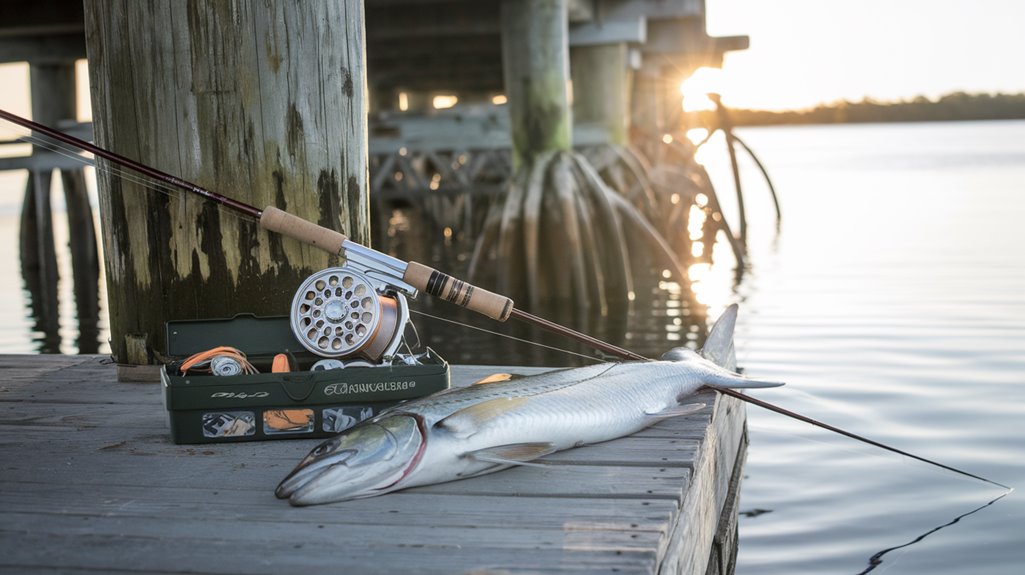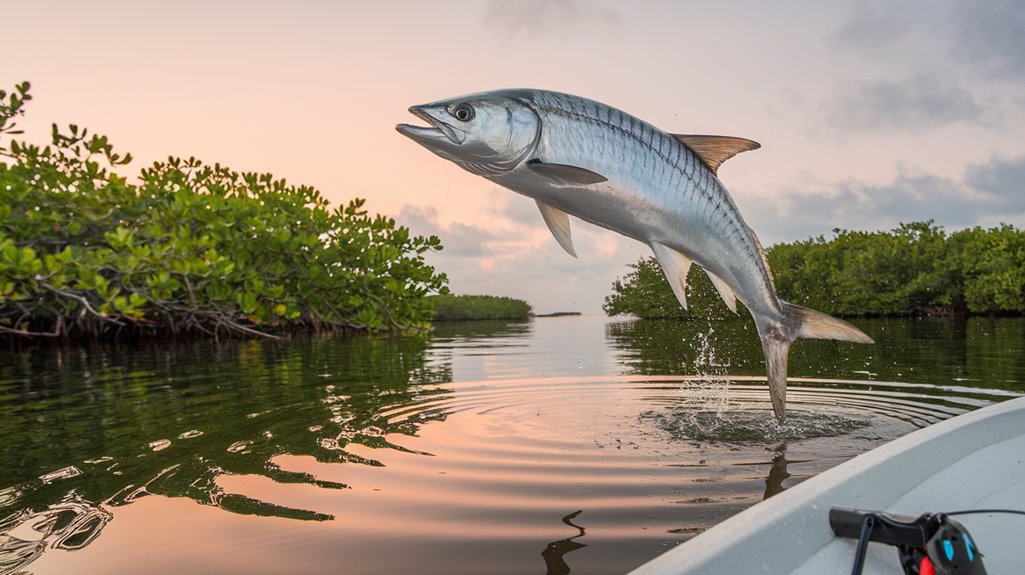You'll find the tides, the temperatures, and the timing all play vital roles in Matlacha's tarpon fishing success. When you're planning your Silver King pursuit in this Gulf Coast paradise, understanding the seasonal patterns can mean the difference between a memorable hookup and a frustrating day on the water. The migration peaks from late April through mid-June, but that's just the beginning of what you need to know about targeting these magnificent gamefish in Matlacha's rich waters.
- Key Takeaways
- The Legendary Silver Kings of Matlacha
- Prime Seasons for Tarpon Action
- Understanding Local Migration Patterns
- Essential Gear and Tackle Setup
- Weather and Water Conditions
- Top Fishing Spots Around Matlacha
- Charter Options and Guide Services
- Conservation and Catch Guidelines
- Monthly Fishing Breakdown
- Advanced Techniques for Success
- Planning Your Tarpon Adventure
- Local Regulations and Permits
- Frequently Asked Questions
- Conclusion
Key Takeaways
- Peak tarpon fishing occurs from late April through mid-June when large schools migrate through Matlacha's waters towards Boca Grande Pass.
- May offers optimal sight fishing conditions with 7-12 daily hookup opportunities and abundant fish along beaches.
- Early season (March-April) yields multiple hookups with tarpon ranging 50-200+ pounds in size.
- Water temperatures around 75°F provide ideal fishing conditions, typically occurring during spring migration months.
- Resident tarpon can be found year-round near bridge structures, with consistent fishing extending through September.
The Legendary Silver Kings of Matlacha
The majestic tarpon, known as the "silver king," has made Matlacha one of Florida's premier fishing destinations for over a century. Since 1885, anglers have pursued these magnificent gamefish, which can reach lengths over 7 feet and weights up to 300 pounds in local waters. You'll find the most productive fishing season during their peak migration from April through June, when massive schools navigate through Matlacha's rich waters.
The legacy of tarpon fishing here was shaped by innovators like William H. Wood, whose techniques revolutionized the sport. When water temperatures hit 75°F, you'll experience ideal conditions for hooking these powerful fighters. As a conservation-minded angler, you'll want to practice catch-and-release, ensuring these protected species continue thriving for future generations to experience the thrill of battling Matlacha's legendary silver kings.
Prime Seasons for Tarpon Action
You'll find peak tarpon action during the late April to mid-June migration window, when these magnificent gamefish surge toward Boca Grande Pass in impressive numbers. During this prime period, you can expect 7-12 hookups per day, with excellent sight fishing opportunities as schools of tarpon move through Matlacha's waters. While the peak migration offers the most intense action, you'll still find productive fishing through September with resident tarpon, though October signals the beginning of the seasonal slowdown.
Peak Migration Windows Open
When spring's warmth settles over Matlacha's waters, tarpon begin their annual migration toward Boca Grande Pass, creating prime fishing conditions from April through June. You'll witness the tarpon season intensify as migratory patterns peak, offering exceptional sight fishing opportunities throughout these vital months.
- April marks your entry into consistent action, as feeding patterns become more predictable with the arrival of migratory fish
- May delivers premium sight fishing conditions, yielding 7-12 hookups daily as the southern migration gains momentum
- June represents peak tarpon activity, with abundant fish cruising the beaches
- August signals the shift to late-season patterns, though resident tarpon remain available
During this peak migration window, you'll experience the finest tarpon fishing Matlacha offers, with each month presenting its unique tactical advantages.
Resident Fish Year-Round Success
Stalwart resident tarpon provide consistent fishing opportunities throughout Matlacha's waters, complementing the seasonal influx of migratory schools. You'll find these resident fish becoming increasingly active as water temperatures rise, particularly during early mornings and late afternoons when feeding patterns peak.
While April through June marks the prime tarpon fishing window, you can successfully target resident fish year-round. Summer months of July and August offer continued action, though activity may moderate during peak heat. Early fall proves especially productive, with September and October providing excellent conditions before cooler weather arrives. You'll maximize your success by focusing on dawn and dusk periods when resident tarpon are most actively feeding, regardless of the season you choose to fish.
Understanding Local Migration Patterns

You'll find Matlacha's tarpon migrations peaking between April and June, when large schools make their way through Boca Grande Pass toward prime feeding grounds. These fish follow established Gulf Stream travel routes, creating concentrated hotspots near Sanibel Island and Fort Myers Beach during the peak season. While resident tarpon inhabit local bridge structures year-round, their numbers surge during the warmer months as migratory patterns align with ideal water temperatures.
Seasonal Movement Peak Times
During the annual migration cycle, tarpon flood into Matlacha's waters between April and June, with May marking the pinnacle of activity as these magnificent gamefish make their way toward Boca Grande Pass. You'll find ideal tarpon fishing conditions as water temperatures climb to 75°F, pushing these predators into shallower, more accessible waters.
Key timing factors for peak season success:
- Target moving tides when tarpon are actively feeding during migration
- Plan your primary fishing efforts between April and early October
- Focus intensively on May for maximum migration activity
- Leverage summer months to target resident tarpon populations
Understanding these seasonal movements is essential for planning your trips. While the primary migration peaks in spring, you'll still encounter excellent opportunities throughout the summer as resident populations establish themselves in local waters.
Gulf Stream Travel Routes
The Gulf Stream's powerful influence shapes tarpon migration patterns throughout Matlacha's coastal waters, creating predictable travel corridors that savvy anglers can exploit. You'll find these magnificent fish following specific routes as water temperature fluctuates throughout the year, particularly during their prime movement period from April through June.
When water temperatures reach 75°F, you'll notice tarpon shifting toward shallower waters, especially around Boca Grande Pass. During peak migration, you'll want to focus your tarpon fishing efforts during moving tides, when these fish are most active. However, from November to February, they'll retreat to deeper Gulf waters, making catches more challenging. Understanding these consistent annual patterns and their relationship to the Gulf Stream's currents will greatly improve your success rate on the water.
Local Population Hotspots
Successful tarpon fishing in Matlacha depends heavily on recognizing key population hotspots throughout the region's diverse waterways. You'll find these magnificent fish year-round, with peak activity during their April to June migration toward Boca Grande Pass. The warm waters surrounding Sanibel Island and Fort Myers Beach offer prime tarpon fishing opportunities during these migration periods.
- Track moving tides for ideal feeding behavior
- Target deeper Gulf waters during cooler months
- Focus on Boca Grande Pass during spring migration
- Monitor water temperatures around Sanibel Island hotspots
Understanding these local patterns is essential for good tarpon fishing success. While they're present year-round, their locations shift predictably with seasonal changes and water conditions. You'll need to adjust your fishing strategy accordingly, moving between shallow and deeper waters as temperatures fluctuate throughout the year.
Essential Gear and Tackle Setup

Preparing the right gear setup forms the foundation of a productive tarpon fishing expedition in Matlacha's waters. You'll need a medium to heavy-action rod between 7 and 8 feet in length – a configuration that any experienced fishing guide will recommend for handling tarpon's explosive runs and aerial displays. Most tarpon fishing charters outfit their reels with 50 to 80-pound braided line for maximum sensitivity and strength.
Select circle hooks between 5/0 and 8/0, which greatly reduce gut-hooking while maintaining solid hookup ratios. Stock your tackle box with both live bait options like mullet and crabs, as well as artificial lures such as soft plastics and topwater plugs. Don't forget to bring a proper landing net or gaff to guarantee safe catch-and-release practices that minimize stress on these magnificent gamefish.
Weather and Water Conditions
Understanding ideal weather and water conditions is paramount for targeting tarpon in Matlacha's rich fishing grounds. You'll find these magnificent gamefish most active when water temperatures hover around 75°F, typically during the spring migration from April through June. Weather conditions greatly impact tarpon fishing success, with overcast days often providing better opportunities for strikes.
- Monitor water temperatures closely – peak activity occurs between late spring and early summer
- Track lunar phases and tidal movements for best fishing windows
- Plan your trips during moving tides, especially around new and full moons
- Watch for cloud cover, as overcast conditions can trigger increased feeding activity
During summer months, you'll need to adjust your strategy as high water temperatures can decrease tarpon activity, making early morning or evening fishing more productive.
Top Fishing Spots Around Matlacha
You'll find world-class tarpon action at Boca Grande Pass, where massive schools congregate during the April-to-June migration season. The inshore mangrove systems around Matlacha offer excellent opportunities to target rolling tarpon, particularly in tidal creeks where baitfish gather. When fishing these spots, you can easily access both the legendary pass waters and the protected mangrove areas through local charter services that know the prime locations.
Boca Grande Pass Spots
Boca Grande Pass stands as Florida's premier tarpon fishing destination, earning its reputation as the "Tarpon Capital of the World." From April through June, massive schools of tarpon concentrate in these waters during their peak migration, creating unparalleled fishing opportunities.
When planning your Boca Grande Pass tarpon fishing expedition, consider these essential factors for success:
- Monitor tidal movements closely, as strong currents greatly influence tarpon activity and feeding patterns
- Position your boat strategically along the pass's deeper channels where tarpon typically congregate
- Time your visits during peak migration months (April-June) for maximum catch potential
- Take advantage of both resident and migratory tarpon populations, offering year-round fishing opportunities
The pass's unique combination of deep waters, strong currents, and consistent tarpon presence makes it an exceptional destination for anglers seeking trophy catches.
Inshore Mangrove Hotspots
While Boca Grande Pass dominates tarpon fishing headlines, Matlacha's intricate network of inshore mangrove habitats offers equally impressive opportunities for both resident and migratory tarpon.
You'll find the most productive fishing during moving tides along mangrove island edges, where tarpon actively feed in these nutrient-rich environments. When targeting these spots, focus on the tidal creeks and backcountry waters where mangroves create natural sanctuaries.
Location | Best Fishing Time
—|—
North Matlacha Mangroves | Dawn/Dusk
Backcountry Creeks | Moving Tides
Eastern Shore Islands | April-June
Western Mangrove Points | Incoming Tide
South Matlacha Pass | Peak Migration
Live bait presentations near these mangrove structures yield the highest success rates, particularly during the prime migration months of April through June when tarpon congregate in these sheltered waters.
Charter Options and Guide Services
When planning a tarpon fishing excursion in Matlacha, several established charter services offer specialized experiences tailored to this prized gamefish. You'll find options ranging from Fish Tank Charters' intimate 18-foot vessel to Day Shape Fishing Charters' larger 26-foot boat, each providing distinct advantages for your tarpon trips.
For ideal results during your charter experience:
- Book during peak tarpon season (April-June) for maximum fishing opportunities
- Select a vessel size appropriate for your group (3-6 persons)
- Verify your guide's expertise with local seasonal patterns
- Confirm the charter's commitment to catch-and-release practices
Local guides combine extensive knowledge of Matlacha's waters with proven techniques, ensuring you're positioned at prime locations during ideal feeding times. Most services offer instant booking confirmation, allowing you to secure your preferred dates efficiently.
Conservation and Catch Guidelines
To preserve Matlacha's thriving tarpon population, strict catch-and-release regulations govern all fishing activities in these waters. You'll need to follow specific conservation guidelines that protect these magnificent game fish while ensuring their long-term survival.
When targeting tarpon, you're required to use single hooks only, and you must fish with just one line. Keep your fight time under 30 minutes to prevent excessive stress on the fish. For specimens over 40 inches, maintain them in the water during hook removal and photography. You'll want to capture photos while the tarpon remains submerged, minimizing handling and potential harm.
These catch-and-release protocols aren't just recommendations – they're essential practices that safeguard Matlacha's tarpon population for future generations of anglers.
Monthly Fishing Breakdown
Successful tarpon fishing in Matlacha depends heavily on understanding the seasonal patterns throughout the year. The tarpon fishing kicks into gear when water temperatures exceed 70°F, typically in March, with seasoned anglers targeting both resident and migratory fish. While January presents limited opportunities, the action steadily builds through spring, culminating in peak season during June.
- Early season (March-April): Multiple hookups possible with tarpon 50-200+ pounds
- Peak season (May-June): Prime sight fishing along beaches
- Extended season (July-October): Consistent fishing opportunities continue
- Late season (November): Last chances before water temperatures drop below 70°F
Understanding these monthly patterns helps you maximize your success when targeting the Silver King in Matlacha's waters.
Advanced Techniques for Success
Mastering advanced tarpon fishing techniques in Matlacha requires a sophisticated understanding of both bait presentation and environmental factors. You'll need to strategically position your live bait at various depths, adapting to the tarpon's feeding patterns during peak tidal movements. When fishing in Fort Myers and surrounding waters, monitor temperatures closely until they reach 75°F, signaling prime tarpon fever conditions.
Deploy light tackle with substantial hooks, but remember to limit your fight time to 30 minutes for responsible catch-and-release practices. Target the final hour of incoming tide and first hour of outgoing tide for ideal results. Your bait selection should focus on local favorites like crabs and mullet, presenting them naturally with the current to entice these powerful gamefish into striking.
Planning Your Tarpon Adventure
Trophy tarpon season beckons anglers to Matlacha during the prime months of April through June, when these magnificent gamefish migrate through Pine Island Sound's pristine waters. You'll need to plan strategically to maximize your chances of success during this peak period.
Essential planning steps for your tarpon fishing expedition:
- Book your charter well in advance, as experienced guides fill their calendars quickly during migration season
- Study local tide charts to identify ideal fishing windows when tarpon are most active
- Confirm you're equipped with proper gear, including circle hooks and suitable tackle for catch-and-release practices
- Familiarize yourself with local conservation guidelines, including proper handling techniques and water-release photography protocols
Understanding these fundamentals will help you navigate Matlacha's waters effectively while contributing to sustainable tarpon fishing practices.
Local Regulations and Permits
Before casting your line in Matlacha's waters, you'll need to navigate Florida's specific tarpon fishing regulations designed to protect these prized gamefish. You must obtain a Florida fishing license through online platforms or local vendors before pursuing tarpon in these waters.
The local regulations mandate strict catch-and-release practices, prohibiting the harvest of any tarpon. You're required to use single hooks only, as treble hooks are forbidden to minimize potential injury to the fish. When handling larger specimens measuring over 40 inches, you must keep them in the water during photography and hook removal to guarantee their survival. Stay current with regulatory changes, as requirements can evolve to maintain sustainable fishing practices in Matlacha's waters.
Frequently Asked Questions
What Is the Best Month to Fish Tarpon in Florida?
You'll find May offers the prime tarpon fishing in Florida, as the southern migration peaks and water temperatures hit ideal levels around 75°F, creating excellent sight fishing conditions.
What Time Is Best for Tarpon?
Want to land that trophy tarpon? You'll find the best action from dawn until 10 AM and again from 4 PM until dusk, when they're actively feeding in cooler temperatures.
Can You Catch Tarpon in October in Florida?
You can catch tarpon in October, but they're less active as water temperatures drop. You'll find better success targeting resident fish in deeper back bays and structures where temperatures remain stable.
What Is the Best Tide to Fish for Tarpon?
You'll find tarpon most active during moving tides, particularly the incoming and outgoing phases. Target these changes when the water's flowing steadily but not too strong for ideal feeding conditions.
Conclusion
You're now primed to tackle Matlacha's legendary silver kings, armed with seasonal intel and technical know-how. Like clockwork, these prehistoric gladiators slice through the waters, offering you shots at glory from spring's migration peak through summer's resident fishery. Whether you're sight-casting to rolling fish or working deep channels, you'll find Matlacha's tarpon scene isn't just fishing—it's an engineering of opportunity where timing meets technique.

